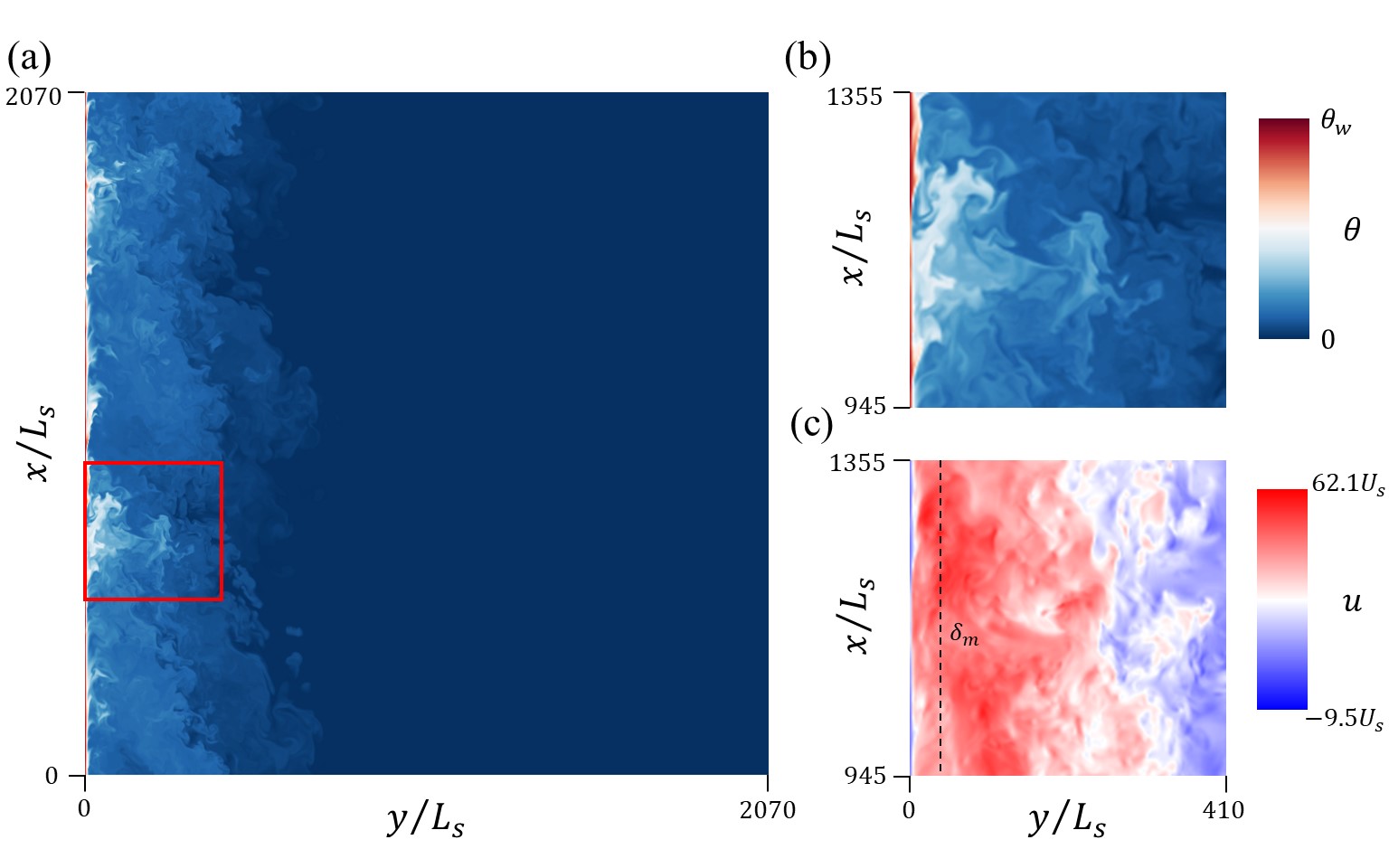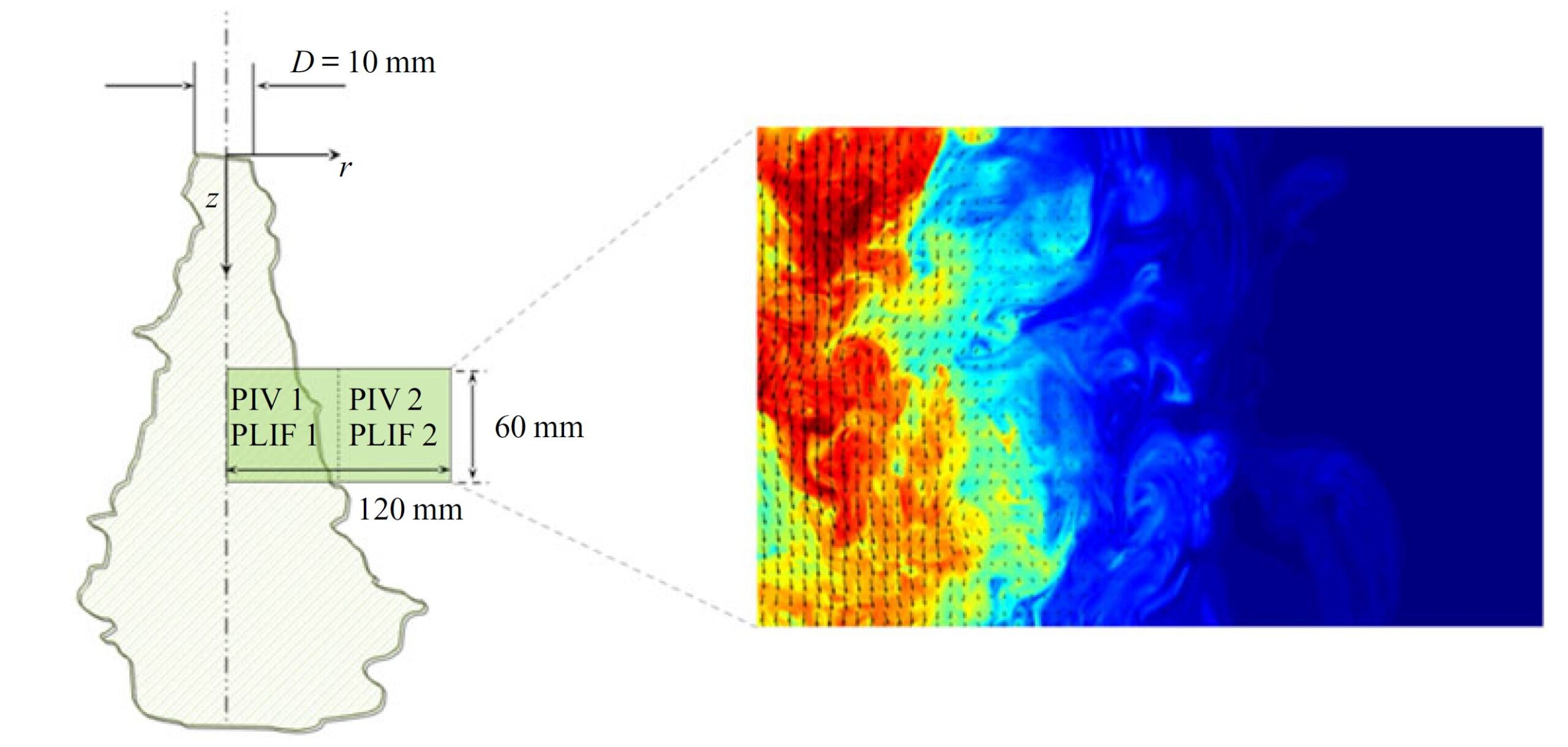Buoyancy-driven flows are common through our built environment and in most industrial processes where heat is exchanged. These flows include natural convection boundary layers, thermal plumes and positively and negatively buoyant jets. Many of the fundamental mechanisms that govern the behaviour of these flows are poorly understood. Improved understanding will lead to increased energy efficiency and better design and modeling tools. Our group has a long history of investigating these flows through large-scale direct numerical solution of the Navier-Stokes equations and laboratory experiments. We have a wide range of active projects. A brief overview of these is presented below. Applications for our PhD program are welcome. Funded opportunities are available.
The work is supported by the following recent ARC discovery project grants: DP220103209,DP160102134. DP130100900, LP100100612, DP0988402
Active researchers in this include: A/Prof Nicholas Williamson, Prof. Steve Armfield
Post-doctoral Research Fellows: Dr. Junhao (Kris) Ke
Active External Collaborations: Prof. Chengwang Li, Prof. Atsuki Komiya, Prof. Nigel Kaye
Transitional and turbulent natural convection boundary layers
The formation and development of natural convection boundary layers from steady low Rayleigh number flow through transition to fully turbulent flow is an area of strong interest in our group. Many of the important features of this basic flow are poorly understood. Of particular interest are the transition behaviour and heat transfer characteristics of these flows. In this work we rely primarily on large-scale direct numerical solution of the Navier-Stokes equations. We work with collaborators in Australia and overseas who provide an experimental perspective to this work.
The work is supported by the following recent ARC discovery project grants:
- DP220103209: Large Scale Natural Convection Boundary Layers with Non-Boussinesq Effects
- DP130100900: Conjugate natural convection boundary layers
- DP0988402: Investigation and optimization of displacement ventilation and cooling
Selected Publications:
- Ke J, Williamson N, Armfield SW, Komiya A. The turbulence development of a vertical natural convection boundary layer. Journal of Fluid Mechanics. 2023;964:A24. doi:10.1017/jfm.2023.382 (Featured in Focus on Fluids: (Wells AJ. From classical to ultimate heat fluxes for convection at a vertical wall. Journal of Fluid Mechanics. 2023;970:F1. doi:10.1017/jfm.2023.665)
- Ke, J., Williamson, N., Armfield, S., Komiya, A., & Norris, S. (2021). High Grashof number turbulent natural convection on an infinite vertical wall. Journal of Fluid Mechanics, 929, A15. doi:10.1017/jfm.2021.839
- Zhou, L., Armfield, S., Williamson, N., Kirkpatrick, M., Lin, W. (2021). Natural convection in a cavity with time-dependent flux boundary. International Journal of Heat and Fluid Flow, 92
- Ke, J., Williamson, N., Armfield, S., Norris, S., Komiya, A. (2020). Law of the wall for a temporally evolving vertical natural convection boundary layer. Journal of Fluid Mechanics, 902, 1-33.
- Zhou, L., Armfield, S., Williamson, N., Kirkpatrick, M., Lin, W. (2020). Natural convection in a cavity with time-varying thermal forcing on a sidewall. International Journal of Heat and Mass Transfer, 150, 1-11
- Ke, J., Williamson, N., Armfield, S., McBain, G., Norris, S. (2019). Stability of a temporally evolving natural convection boundary layer on an isothermal wall. Journal of Fluid Mechanics, 877, 1163-1185.
- Williamson, N., Armfield, S., Kirkpatrick, M. (2012). Transition to oscillatory flow in a differentially heated cavity with a conducting partition. Journal of Fluid Mechanics, 693(25 February 2012), 93-114.
- Aberra, T., Armfield, S., Behnia, M., McBain, G. (2012). Boundary layer instability of the natural convection flow on a uniformly heated vertical plate. International Journal of Heat and Mass Transfer, 55(21-22), 6097-6108.
- McBain, G., Chubb, T., Armfield, S. (2009). Numerical solution of the Orr-Sommerfeld equation using the viscous Green function and split-Gaussian quadrature. Journal of Computational and Applied Mathematics, 224(1), 397-404
- McBain, G., Armfield, S., Desrayaud, G. (2007). Instability of the buoyancy layer on an evenly heated vertical wall. Journal of Fluid Mechanics, 587, 453-469.
For more information, please contact: A/Prof Nicholas Williamson, Prof. Steve Armfield

Journal of Fluid Mechanics , Volume 929, 25 December 2021, A15
Convective Free Shear Flows: Plumes, Buoyant Jets and Fountains
Thermal plumes and buoyant jets form in many heating and ventilation applications and also in environmental contexts. The turbulent exchange of heat, momentum and mass with the surrounding fluid dictates the evolution of the flow. The unknown dependence of these fluxes on the flow is a key uncertainty and limitation on current modelling. A current focus of our work is to understand the characteristics of the turbulent exchange flow. In this work our group uses our research computational fluid dynamics codes to perform large-scale direct numerical solution of the Navier-Stokes equations. We also obtain experimental results through our environmental fluid mechanics laboratory.
The work is supported by the following recent ARC discovery project grants:
- DP160102134: Entrainment and mixing in turbulent negatively buoyant jets and fountains
- DP0988402: Investigation and optimization of displacement ventilation and cooling
Selected Publications:
- Milton-McGurk L, Williamson N, Armfield SW. Predicting radial profiles for jets with arbitrary buoyancy. Journal of Fluid Mechanics. 2023;956:A9. doi:10.1017/jfm.2023.20
- Talluru KM, Williamson N, Armfield SW. Entrainment and dilution in a fountain top. Journal of Fluid Mechanics. 2022;941:A24. doi:10.1017/jfm.2022.292
- Milton-McGurk L, Williamson N, Armfield SW, Kirkpatrick MP. Characterising entrainment in fountains and negatively buoyant jets. Journal of Fluid Mechanics. 2022;939:A29. doi:10.1017/jfm.2022.152
- Milton-McGurk, L., Williamson, N., Armfield, S., Kirkpatrick, M., Talluru, K. (2021). Entrainment and structure of negatively buoyant jets. Journal of Fluid Mechanics, 911, A21
- Milton-McGurk, L., Williamson, N., Armfield, S., Kirkpatrick, M. (2020). Experimental investigation into turbulent negatively buoyant jets using combined PIV and PLIF measurements. International Journal of Heat and Fluid Flow, 82, 1-8.
- Talluru, K., Armfield, S., Williamson, N., Kirkpatrick, M., Milton-McGurk, L. (2020). Turbulence structure of neutral and negatively buoyant jets. Journal of Fluid Mechanics, 909, 1-26.
- Inam, M., Lin, W., Williamson, N., Armfield, S., He, Y. (2019). Characteristics of unsteadiness for transitional plane fountains in linearly stratified fluids. International Communications in Heat and Mass Transfer, 100(January 2019), 83-97.
- Huang, D., Williamson, N., Armfield, S. (2019). Entrainment in pulsing plumes. Experiments in Fluids: experimental methods and their applications to fluid flow, 60(8), 1-10.
- Hattori, T., Norris, S., Kirkpatrick, M., Armfield, S. (2013). Prandtl number dependence and instability mechanism of the near-field flow in a planar thermal plume. Journal of Fluid Mechanics, 732, 105-127.
- Williamson, N., Armfield, S., Lin, W. (2011). Forced turbulent fountain flow behaviour. Journal of Fluid Mechanics, 671, 535-558.
- Williamson, N., Armfield, S., Lin, W. (2010). Transition behaviour of weak turbulent fountains. Journal of Fluid Mechanics, 655, 306-326.
- Williamson, N., Nagarathinam, S., Armfield, S., McBain, G., Lin, W. (2008). Low-Reynolds-number fountain behaviour. Journal of Fluid Mechanics, 608, 297-317.
For more information, please contact: Prof. Steve Armfield, A/Prof Nicholas Williamson.

Image of a fountain obtained using dye visualisation

Journal of Fluid Mechanics , Volume 911, 25 March 2021, A21
Natural Ventilation and Cooling and HVAC
The use of buoyancy due to varying air density within a building to drive ventilating flow is attractive from an energy efficiency perspective. A primary difficulty in modeling these flows is the dependence of the density field on the flow itself. An understanding of the turbulent exchange of mass and momentum is critical to making accurate model predictions. Our group works to understand these mass and momentum exchanges and also develop simple models of the internal flow within a naturally ventilated building. This work has both a fundamental and applied focus.
The work is supported by the following recent ARC project grants:
- LP100100612: Design tools for optimizing data centre layout to minimize energy usage
- DP0988402: Investigation and optimization of displacement ventilation and cooling
For more information, please contact: A/Prof Nicholas Williamson. Prof. Steve Armfield,
Selected Publications:
- Kaye, N., Williamson, N., Huang, D., Armfield, S. (2021). Buoyancy distribution in a filling box segmented by a planar jet. Environmental Fluid Mechanics, 21, 239-261
- Huang, D., Williamson, N., Armfield, S. (2019). Entrainment in pulsing plumes. Experiments in Fluids: experimental methods and their applications to fluid flow, 60(8), 1-10.

Kaye, N., Williamson, N., Huang, D. et al. Buoyancy distribution in a filling box segmented by a planar jet. Environ Fluid Mech 21, 239–261 (2021).